University of Washington, CSE 142
Lab 3: Graphics, return, if/else, and Scanner
Except where otherwise noted, the contents of this document are Copyright 2011 Stuart Reges and Marty Stepp.
lab document created by Marty Stepp, Stuart Reges, and Whitaker Brand
Basic lab instructions
- We encourage you to talk to your classmates for help. You can even work on the lab with a partner if you like.
- You may want to bring your textbook to future labs to look up syntax and examples.
- Stuck? Confused? Have a question? Ask a TA for help, or look at the book or past lecture slides.
- You probably won't finish all of the exercises. Just do as much as you can within the allotted time. You don't need to keep working on these exercises after you leave the lab.
- Before you leave today, make sure to check in with one of the TAs in the lab to get credit for your work.
Today's lab
Goals for today:
- use the instructor-provided
DrawingPaneland Java'sGraphicsandColorclasses - use
returnvalues to send data between methods - use
if/elsestatements to select between multiple code actions - use
Scannerto create interactive programs that read user input - Where you see this icon, you can click it to check the problem in Practice-It!

Exercise : Check MyUW scores
- The scores you receive on homework and labs are available for you to view in MyUW. Follow the instructions on our MyUW page to check your scores.
- You should see scores for labs 1 and 2. If not, contact your TA or a TA from your lab period.
- Using the information on your MyUW page, fill in the values below.
| class mean for a1 (i.e., average score for assignment 1) | / 10 |
8.90 |
| class mean for lab1 (i.e., average score for lab 1) | / 2 |
1.92 |
Graphics
Now we'll explore several exercises related to drawing graphics.

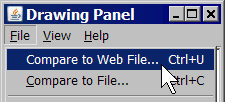
-
We'll use a provided class
DrawingPanelthat works with Java classesGraphics(a "pen" for drawing) andColor. -
Download
DrawingPanel.javato your program directory. -
To check your output in the
DrawingPanel, click File, Compare to URL....
Exercise : Stairs loop table
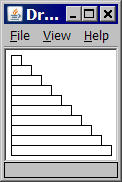
Consider the output at right. The first stair's top-left corner is at position (5, 5). The first stair is 10x10 px in size. Each stair is 10px wider than the one above it.
Fill in the table below with the coordinates and sizes of the first five stairs. Note which values change and which ones stay the same.
| stair | x | y | width | height |
|---|---|---|---|---|
1
|
5 |
5 |
10 |
10 |
2
|
5 |
15 |
20 |
10 |
3
|
5 |
25 |
30 |
10 |
4
|
5 |
35 |
40 |
10 |
5
|
5 |
45 |
50 |
10 |
Exercise : Stairs


Write a complete Java program to draw the stairs. Copy/paste the code template below into jGRASP and fill in your own expressions or values for each stair's x, y, width, and height.
Use your table from the previous slide to help you find the correct expressions.
The values that change for each stair should become expressions in terms of the loop counter variable, i.
import java.awt.*;
public class Stairs1 {
public static void main(String[] args) {
DrawingPanel panel = new DrawingPanel(110, 110);
Graphics g = panel.getGraphics();
for (int i = 0; i < 10; i++) {
g.drawRect(x, y, width, height);
}
}
}
Exercise : Stairs 2

Modify your stairs program to draw one (or all) of the following outputs.
Modify only the body in your for loop.
(You may want to make a new table to find the expressions for x, y, width, and height.)
 →
→
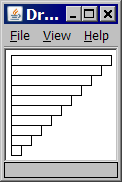
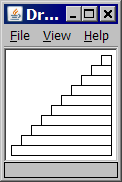
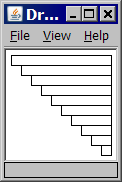
Exercise - answer
To get each output, change the for loop body to the following:
// output 2
g.drawRect(5, 5 + 10*i, 100 - 10*i, 10);
// output 3
g.drawRect(95 - 10*i, 5 + 10*i, 10 + 10*i, 10);
// output 4
g.drawRect(5 + 10*i, 5 + 10*i, 100 - 10*i, 10);
Parameterized methods and Graphics
When you want to divide a graphical program into multiple drawing methods, you must pass Graphics g as a parameter in addition to any other parameters. Example:
public static void main(String[] args) {
DrawingPanel panel = new DrawingPanel(400, 300);
Graphics g = panel.getGraphics();
...
drawStuff(g, 13, 52, 7);
}
public static void drawStuff(Graphics g, int a, int b, int c) {
g.drawLine(a, 45, b, c);
...
}
Exercise : Face 1+2
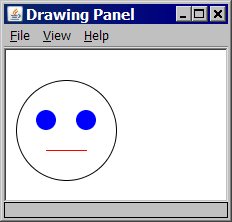
Suppose you have an existing program that draws the "face" figure at right. Let's modify the program using methods and parameters so that we can draw several faces at different locations.
continued on the next slide...
Exercise : Face 2

Modify the Face program to draw the following output.
Write a parameterized method that draws a face at different positions.

- window size: 320 x 180 px
- faces' top-left corners at (10, 30) and (150, 50)
Exercise - answer
import java.awt.*;
public class Face2 {
public static void main(String[] args) {
DrawingPanel panel = new DrawingPanel(320, 180);
Graphics g = panel.getGraphics();
drawFace(g, 10, 30);
drawFace(g, 150, 50);
}
public static void drawFace(Graphics g, int x, int y) {
g.setColor(Color.BLACK);
g.drawOval(x, y, 100, 100);
g.setColor(Color.BLUE);
g.fillOval(x + 20, y + 30, 20, 20);
g.fillOval(x + 60, y + 30, 20, 20);
g.setColor(Color.RED);
g.drawLine(x + 30, y + 70, x + 70, y + 70);
}
}
Exercise : Face 3

Modify your previous Java program to draw the following output.
Use a for loop with your parameterized method to draw faces at different positions.
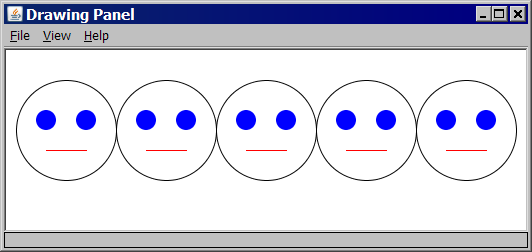
- window size: 520 x 180 px
- faces' top-left at (10, 30), (110, 30), (210, 30), (310, 30), and (410, 30)
Exercise - answer
import java.awt.*;
public class Face3 {
public static void main(String[] args) {
DrawingPanel panel = new DrawingPanel(520, 180);
Graphics g = panel.getGraphics();
for (int i = 0; i < 5; i++) {
drawFace(g, 10 + i * 100, 30);
}
}
public static void drawFace(Graphics g, int x, int y) {
g.setColor(Color.BLACK);
g.drawOval(x, y, 100, 100);
g.setColor(Color.BLUE);
g.fillOval(x + 20, y + 30, 20, 20);
g.fillOval(x + 60, y + 30, 20, 20);
g.setColor(Color.RED);
g.drawLine(x + 30, y + 70, x + 70, y + 70);
}
}
Returning Values
A return value is when a method sends a value back to the code that called it.
public static type name(parameters) { // declare
...
return expression;
}
variableName = methodName(parameters); // call
Example:
public static double fToC(double tempF) {
return (tempF - 32) * 5.0 / 9.0;
}
...
double bodyTemp = fToC(98.6); // bodyTemp stores 37.0
double freezing = fToC(32); // freezing stores 0.0
Math expression syntax
| Method | Description | Example |
|---|---|---|
Math.abs
|
absolute value |
Math.abs(-308) returns 308
|
Math.ceil
|
ceiling (rounds upward) |
Math.ceil(2.13) returns 3.0
|
Math.floor
|
floor (rounds downward) |
Math.floor(2.93) returns 2.0
|
Math.max
|
max of two values |
Math.max(45, 207) returns 207
|
Math.min
|
min of two values |
Math.min(3.8, 2.75) returns 2.75
|
Math.pow
|
power |
Math.pow(3, 4) returns 81.0
|
Math.round
|
round to nearest integer |
Math.round(2.718) returns 3
|
Math.sqrt
|
square root |
Math.sqrt(81) returns 9.0
|
Exercise - Math expressions
Write the results of each expression.
Use the proper type (such as .0 for a double).
Note that a variable's value changes only if you re-assign it using the = operator.
double grade = 2.7; Math.round(grade); // grade = 2.7 grade = Math.round(grade); // grade = 3.0 double min = Math.min(grade, Math.floor(2.9)); // min = 2.0 double x = Math.pow(2, 4); // x = 16.0 x = Math.sqrt(64); // x = 8.0 int count = 25; Math.sqrt(count); // count = 25 count = (int) Math.sqrt(count); // count = 5 int a = Math.abs(Math.min(-1, -3)); // a = 3
Exercise : area

Consider the following method for converting milliseconds into days:
// converts milliseconds to days
public static double toDays(double millis) {
return millis / 1000.0 / 60.0 / 60.0 / 24.0;
}
Write a similar method named area that takes as a parameter the radius of a circle and that returns the area of the circle.
For example, the call area(2.0) should return 12.566370614359172.
Recall that area can be computed as π times the radius squared and that Java has a constant called Math.PI.
- (Try solving this problem in Practice-It by clicking the icon above.)
Exercise : pay

Write a method named pay that accepts two parameters: a real number for a TA's salary, and an integer for the number of hours the TA worked this week.
The method should return how much money to pay the TA.
For example, the call pay(5.50, 6) should return 33.0.
The TA should receive "overtime" pay of 1 ½ normal salary for any hours above 8.
For example, the call pay(4.00, 11) should return (4.00 * 8) + (6.00 * 3) or 50.0.
- (Try solving this problem in Practice-It by clicking the icon above.)
if/else Statements
An if/else statement lets your program choose between 2 or more options.
if (test) {
statement(s);
} else {
statement(s);
}
Example:
if (gpa >= 2.0) {
System.out.println("Welcome to Mars University!");
} else {
System.out.println("Please apply again soon.");
}
Exercise : if/else mystery
Consider the following Java code. Fill in the boxes with the output produced by each of the method calls.
public static void mystery(int n) {
System.out.print(n + " ");
if (n > 10) {
n = n / 2;
} else {
n = n + 7;
}
if (n * 2 < 25) {
n = n + 10;
}
System.out.println(n);
}
|
|
Exercise : numUnique

Write a method named numUnique that accepts three integers as
parameters and that returns the number of unique integers among the three.
For example, the call numUnique(18, 3, 4) should return 3
because the parameters have 3 different values. By contrast, the
call numUnique(6, 7, 6) would return 2 because there are only
2 unique numbers among the three parameters: 6 and 7.
- (Try solving this problem in Practice-It by clicking the icon above.)
User input and Scanner
| Method name | Description |
|---|---|
nextInt()
|
reads and returns the next token as an int, if possible
|
nextDouble()
|
reads and returns the next token as double, if possible
|
next()
|
reads and returns a single word as a String
|
nextLine()
|
reads and returns an entire line as a String
|
Example:
import java.util.*; // so you can use Scanner
...
Scanner console = new Scanner(System.in);
System.out.print("How old are you? "); // prompt
int age = console.nextInt();
System.out.println("You typed " + age);
Exercise : DevryAdmit

Write a complete program DevryAdmit with the behavior shown below.
Use the Scanner to read user input for a student's grade point average and SAT exam score.
A GPA below 1.8 will cause the student to be rejected; an SAT score below 900 will also cause a rejection. Otherwise the student is accepted.
Devry University admission program What is your GPA? 3.2 What is your SAT score? 1280 You were accepted!
Check your answer using Practice-It from the check-mark icon above.
Exercise : AgeCheck
-
Copy/paste and save the following program in jGRASP,
then see the instructions on the next slide.
public class AgeCheck { public static void main(String[] args) { int myAge = 19; // I am 19; let me see if I can drive message(myAge); } // Displays message about driving to user based on given age public static void message(int age) { if (myAge >= 16) { System.out.println("I'm old enough to drive!"); } if (myAge <= 16) { System.out.println("Not old enough yet... :*("); } } }
Exercise - things to fix
- The program has a few syntax errors. Fix them until it compiles.
- The code has a logic problem. (For some value(s), it prints the wrong answer.) Find any such problems and fix them. (You may need to run the program a few times and try different values to see which ones fail.)
-
The program uses
ifandelsein a clumsy way. Improve the style of the code.
Exercise - answer
-
The following is a corrected version of the program:
public class AgeCheck { public static void main(String[] args) { int myAge = 19; // I am 19; let me see if I can drive message(myAge); } // Displays a message about driving to user based on given age public static void message(int age) { if (age >= 16) { System.out.println("I'm old enough to drive!"); } else { System.out.println("Not old enough yet... :*("); } } }
Exercise : AgeCheck2
-
Now replace your previous
AgeCheckprogram'smessagemethod with:// Possibly prints some message(s) to the user based on the given age public static void message(int age) { if (age >= 21) { System.out.println("I can legally purchase alcohol!"); } else if (age >= 17) { System.out.println("I can purchase a ticket to an R-rated movie."); } else if (age >= 16) { System.out.println("I can get my driver's license!"); } } -
For some age(s), the message(s) printed are not accurate. (In some
cases, it should print no messages; in some cases, one message; and in
others, many messages.) Improve the usage of
ifs andelses in this method to behave properly.
if/else factoring
-
It's easy to introduce redundancy in the branches of
an
if/else. For example:if (x < 30) { a = 2; x++; System.out.println("CSE 142 TAs are awesome! " + x); } else { a = 2; System.out.println("CSE 142 TAs are awesome! " + x); } -
The code can be factored out to become: (notice that
the
elsewent away!)a = 2; if (x < 30) { x++; } System.out.println("CSE 142 TAs are awesome! " + x);
Exercise : if/else Factoring
-
Download the following program
 FactorExample.java
to your machine and open it with jGrasp.
FactorExample.java
to your machine and open it with jGrasp.
- The program's method is redundant. Factor the method, restructuring the code to eliminate unnecessary statements while retaining the same behavior.
-
Insert some test calls of the method
in
mainand run it to make sure it works properly.
Exercise : Syntax errors
-
The following Java program has 7 errors. Can you find all of them?
1 2 3 4 5 6 7 8 9 10 11 12 13 14 15 16 17 18
public class IfOops { public static void main(String[] args) { int a = 7, b = 42; minimum(a, b); if {smaller = a} { System.out.println("a is the smallest!"); } } public static void minimum(int a, int b) { // returns which int is smaller if (a < b) { int smaller = a; } else (a => b) { int smaller = b; } return int smaller; } } - Copy and paste the code into jGrasp and see if you can fix the errors.
Exercise - answer
- line 5:
ifstatement should use()parentheses, not{}brackets - line 5:
=should be== - line 5:
smalleris out of scope here - line 10:
voidshould beint - line 13:
=>should be>=(or better yet, noiftest is needed) - line 16: should not write variable's type of
intwhen returning it - line 16:
int smalleris out of scope here (declare outsideifor return directly)
Exercise - Corrected version
-
public class IfOops { public static void main(String[] args) { int a = 7, b = 42; int smaller = minimum(a, b); if (smaller == a) { System.out.println("a is the smallest!"); } } public staticvoidint minimum(int a, int b) { // returns which int is smaller int smaller; if (a < b) {intsmaller = a; } elseif (a >= b){intsmaller = b; } returnintsmaller; } }
Exercise : seeMovie

You're thinking about going with your friends to a
movie. Write a Java method seeMovie that
accepts two parameters: the cost of a ticket in dollars,
and the rating number of stars the movie received out of
5. The method should print how interested you are (very, sort-of, or not).
Use the following criteria:
- You like bargains. Any movie that costs less than $5.00 is one that you want to see very much.
- You dislike expensive movies. You are not interested in seeing any movie that costs $12.00 or more, unless it got 5 stars (and even then, you are only sort-of interested).
- You like quality. You are very interested in seeing 5-star movies that cost under $12.00.
- You are sort-of interested in seeing movies costing between $5.00 - $11.99 that also got between 2-4 stars inclusive.
- You are not interested in seeing any other movies not described previously.
Exercise : Spiral


Write a Java program that draws the following output using a for loop.
- window size: 170 x 170 px
- "spiral" lines starting from (0, 10), going right 160, down 150, left 150, up 140, right 140, down 130, left 130, up 120, ...
Exercise - answer
import java.awt.*;
public class Spiral {
public static void main(String[] args) {
DrawingPanel panel = new DrawingPanel(170, 170);
Graphics g = panel.getGraphics();
for (int i = 0; i < 8; i++) {
g.drawLine( 10*i, 10 + 10*i, 160 - 10*i, 10 + 10*i); // top
g.drawLine(160 - 10*i, 10 + 10*i, 160 - 10*i, 160 - 10*i); // right
g.drawLine( 10 + 10*i, 160 - 10*i, 160 - 10*i, 160 - 10*i); // bottom
g.drawLine( 10 + 10*i, 20 + 10*i, 10 + 10*i, 160 - 10*i); // left
}
}
}
Exercise - answer, alternative version
import java.awt.*;
public class Spiral {
public static void main(String[] args) {
DrawingPanel panel = new DrawingPanel(170, 170);
Graphics g = panel.getGraphics();
int x = 0, y = 10;
int len = 160;
for (int i = 0; i < 8; i++) {
g.drawLine(x, y, x + len, y); // right
x = x + len;
len = len - 10;
g.drawLine(x, y, x, y + len); // down
y = y + len;
g.drawLine(x, y, x - len, y); // left
x = x - len;
len = len - 10;
g.drawLine(x, y, x, y - len); // up
y = y - len;
}
}
}
If you finish them all...
If you finish all the exercises, try out our Practice-It web tool. It lets you solve Java problems from our Building Java Programs textbook.
You can view an exercise, type a solution, and submit it to see if you have solved it correctly.
Choose some problems from the book and try to solve them!